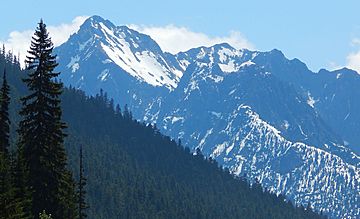Porcupine Peak (Washington) facts for kids
Quick facts for kids Porcupine Peak |
|
|---|---|

Porcupine Peak from eastbound North Cascades Highway
|
|
| Highest point | |
| Elevation | 7,762 ft (2,366 m) |
| Prominence | 922 ft (281 m) |
| Geography | |
| Parent range | North Cascades |
| Topo map | USGS Washington Pass |
| Type of rock | Granite |
| Climbing | |
| Easiest route | Climb, class 3 |
Porcupine Peak is a mountain that stands 7,762 feet (about 2,366 meters) tall. It is located in Okanogan County in Washington state, USA. This peak is part of the Okanogan Range, which is a smaller part of the larger North Cascades mountain range.
You can find Porcupine Peak north of Rainy Pass and south of Mount Hardy. The land around it is managed by the Okanogan National Forest. The closest taller mountain is Cutthroat Peak, which is about 2.19 miles (3.52 km) to the southeast. You can see Porcupine Peak from the North Cascades Highway, which runs along the mountain's lower southwest side. Rain and melting snow from the mountain flow into Porcupine Creek, Swamp Creek, and Granite Creek. These three creeks almost surround the mountain and eventually flow into the Skagit River.
What's the Weather Like at Porcupine Peak?
Porcupine Peak is in a "marine west coast" climate zone. This means it has weather similar to places near the ocean in western North America. Most of the weather systems start over the Pacific Ocean. They then travel northeast towards the Cascade Mountains.
When these weather systems reach the North Cascades, the tall peaks force the air upwards. As the air rises, it cools down and drops its moisture. This creates a lot of rain or snowfall on the mountains. This process is called "orographic lift." Because of this, the western side of the North Cascades gets a lot of rain and snow, especially in winter.
During winter, the weather is often cloudy. But in summer, high-pressure systems over the Pacific Ocean become stronger. This often leads to clear skies with little or no clouds. Because the ocean affects the weather, the snow tends to be wet and heavy. This can make the risk of avalanches higher.
How Porcupine Peak Was Formed
The North Cascades mountains have very rugged land. You can see sharp peaks, long ridges, and deep valleys carved by glaciers. These different shapes and big changes in height happened over millions of years. This also led to different climates and types of plants in the area.
The Cascade Mountains started forming millions of years ago. This was during a time called the late Eocene Epoch. The North American Plate (a huge piece of Earth's crust) was slowly moving over the Pacific Plate. This movement caused many volcanic eruptions and created new rocks.
Also, small pieces of Earth's crust, called terranes, came together. These pieces, from both the ocean floor and continents, helped build the North Cascades. This happened about 50 million years ago.
Later, during the Pleistocene period (which started over two million years ago), glaciers grew and shrank many times. As they moved, these huge ice sheets scraped and shaped the land. They left behind piles of rock and dirt. The river valleys in this area have a "U" shape. This shape was created by these recent glaciers. The mountains also got taller through processes called uplift and faulting. These actions, along with the glaciers, created the tall peaks and deep valleys we see in the North Cascades today.




